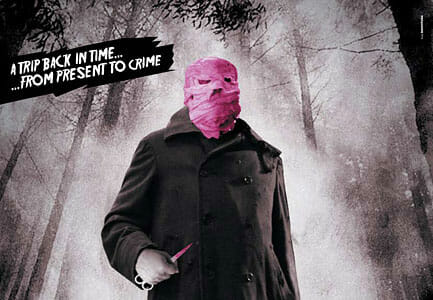[Above: Los Cronocrímenes]
Nacho Vigalondo, the director of the Spanish sci-fi caper Los Cronocrímenes (aka Timecrimes), had taken the stage at the Route 66 nightclub – a party hub situated on a street known as Disco Alley in this Catalonian resort town. His movie, a clever mystery about time travel and multiple identities, was a crowdpleaser at its big public screening that evening. And it was time for the young filmmaker to show that this was no coincidence.
Already possessed of an cerveza-fueled enthusiasm, Vigalondo hopped up with the band that was headlining the afterhours bash, and began belting into the microphone, as two black-haired vamps sandwiched him between their gyrating hips. He was singing something in Spanish, something very urgent and apparently very, very funny. Between verses, he saluted the crowd with mock-fascist gestures. Everyone pogoed like it was 1977. But what was Vigalondo telling us?
“Oh,” a Spanish-speaking festival-goer told me. “He’s singing, ‘My penis smells like the cinema.'” A-ha! Truth be told, after a week of rolling around Sitges, from the parties that ended a little shy of daybreak to the daily marathon screenings that began just a couple of hours later, to reek merely of celluloid was a good thing. Although Cronocrímenes got passed over by the prize juries, it was one of several strong entries from France and Spain that made this year a thrilling one at Sitges.
The film’s plot emulates classic pulp science fiction, redolent of Alfred Bester or Philip K. Dick, as a middle-aged man finds his quiet afternoon disturbed by an intruder. Soon, he begins stalking, and being stalked by, a mysterious figure whose face is disguised in pink medical gauze. There’s also a naked girl involved, and a research scientist (Vigalondo) in an adjacent office park who happens to be testing out a new time machine. The bogeyman is an homage to James Whale’s 1933 film, The Invisible Man, but his identity doesn’t stay secret for long. Watching the Chinese Box-like narrative unravel is the whole point, and Vigalondo choreographs the action with a suspenseful touch that nods subtly towards the surrealist prankery of a Luis Bunuel, who once sat on a Sitges jury.
This year’s judges were moved by The Fall, voting it best film. Tarsem Singh, best-known as a rock-video auteur whose “Losing My Religion” clip helped speed R.E.M. to early-’90s glory, shot epic vistas in something like 37 countries for this old-school epic. He conjures a cross between the mystical tableaux of Jodoworsky’s The Holy Mountain and the make-believe whimsy of Terry Gilliam (in his nicer moments). The premise sounds like a good novel: in the 1920s, a severely injured Hollywood stuntman befriends a little girl recuperating in the same hospital. He tells her a grandiose fable about a noble band of thieves, and in exchange she steals morphine for him, as the actor intends to kill himself over a heartbreak. But for a movie about storytelling the actual story is pretty weak, wholly overwhelmed by the costumes, design and cinematography. Fall Asleep might be a more fitting title.
That was impossible during Takashi Miike’s Sukiyaki Western Django. The Japanese cult director takes a step back from the nerve-wrattling violence and psychological torture of Auditon and Ichi the Killer to rewire the Western genre. Think Deadwood gone otaku. The gunslinging saga, with dialogue spoken in perversely (and haltingly) phonetic English, scored much-deserved awards for cinematography and design, and boasted the festival’s inevitable Quentin Tarantino cameo.
The real story of Sitges 07, however, was the fierce comeback of the zombie movie. As if the undead ever really go away. Although likely Oscar contender The Orphanage got much of the spotlight, it was the scrappy [REC], by directors Jaume Balagueró and Paco Plaza, that stole the festival, copping the prize for best direction, among several others. Much as zombie-daddy George A. Romero’s Diary of the Dead, the scenes are shot from the point-of-view of a first-person video camera. The set-up? A Spanish reality show hostess is following local firemen on the nightly rounds, which leads them to an apartment building whose residents – we are soon to learn – are afflicted with a strange virus. What happens next is pure Zombie 101, given a severe jolt of new voltage thanks to imaginative rigging of familiar spookhouse dynamics, Almodovarian spoofery of media absurdity, and the shaky veracity of that hand-held cam.
How scary is it? The film’s crew secretly taped the audience during one of [REC]‘s screenings. Check it out.
There was much banter about the possibility of a Hollywood remake of [REC], much in the way that so many Asian horror flicks have been adapted (and, mostly, ruined) for American audiences. Hopefully, the festival buzz will win the film at least a short domestic theatrical run before that. The zombies demand it.
